( ESNUG 537 Item 7 ) -------------------------------------------- [03/14/14]
Subject: Amit's post-CDNS-vs.-BDA-lawsuit SPICE trends/predictions for 2014
> - With Synopsys annexing Magma FineSim through the recent acquisition,
> Synopsys will monopolize the Custom Digital/IO and Memory/Standard
> Cell Library territories. Synopsys will recapture their estimated
> $70 million/year in lost business to Magma, and with Magma's history
> of price cutting and commoditizing now eliminated, the overall market
> size for SPICE tools will increase. This definitely fortresses the
> former Synopsys franchise with its huge margins to counter the low to
> negative margins seen in its IP business.
>
> - FineSim customers will start seeing their Synopsys salespeople after
> the close in Q2 2012, who will tell them how their price is going up
> dramatically. I suspect there will be very little discounting
> considered by Synopsys.
>
> "Reader details how SNPS-LAVA dramatically raises SPICE prices"
> http://www.deepchip.com/items/0496-07.html
From: [ Amit Gupta of Solido Design ]
Hi John,
I thought your DeepChip readers would be interested in an update to the
SPICE Wars piece you published in ESNUG 496 #7 in December 2011. There've
been some new product announcements since then plus the recent Cadence/BDA
lawsuit has been settled.
---- ---- ---- ---- ---- ---- ----
FOUR BIG TRENDS
TREND #1: SMALLER NODES MEANS FEWER PLAYERS
Due to cost, there's been a major move for IDM's to use dedicated foundries
for the advanced nodes. Below is an IHS iSuppli snapshot of the current fab
providers per process node:
45/40 nm 32/28 nm 22/20 nm 16/14 nm
-------- -------- -------- --------
SMIC UMC TSMC TSMC
UMC TSMC GlobalFoundries GlobalFoundries
TSMC GlobalFoundries Intel Intel
GlobalFoundries STMicro Samsung Samsung
Renesas Intel
IBM Samsung
Fujitsu
Toshiba
STMicro
Intel
Samsung
Notice that at 45/40 nm there are 11 fabs. At 16/14 nm only 4 fabs.
The vast majority of SPICE simulation runs we presently see worldwide are
TSMC, Intel, GlobalFoundries and Samsung at 28, 22, 20, 16 and 14 nm. It
would not surprise me if Gary Smith reported that those four fabs accounted
for 95% or more of the world's 2013 SPICE license purchases.
---- ---- ---- ---- ---- ---- ----
TREND #2: 20/16/14 NM DESIGN STARTS ARE ACCELERATING
The move to 20/16/14 nm design is a result of major consumer drivers like
mobile electronics, the internet of things, cloud computing and augmented
reality. These consumer drivers demand semiconductor speed, connectivity,
reliability, battery life, form factor and cost.
For example, the TSMC 16 nm FinFETs vs their 28 nm gets 2X gate density,
38% speed improvement at same power, and 54% improved power saving at the
same speed.
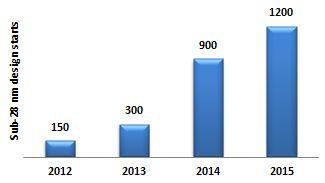 There were 150 sub-28 nm IC design starts in 2012, and 300 design starts in
2013. This is forecasted to grow to 1300 by 2015 -- with only 4 fabs left
making all of these chips.
---- ---- ---- ---- ---- ---- ----
TREND #3: NUMBER OF SPICE RUNS ARE INCREASING 10X to 1,000,000X
20/16/14 nm designs have far more potential failure regions than designers
have historically considered. Just for variation issues, we are seeing:
- PVT corner analysis: 100's-1,000's simulations
Designers must now cover all per-device type process, voltage,
temperature, load, parasitic RC conditions and corners caused
by double patterning lithography.
- 3-sigma design: 3000 simulations
Simulating the 1000's of Monte Carlo variation conditions using
the local and global statistical variation data provided in the
foundry PDK's.
- 4- to 6-sigma designs: millions to billions of simulations
It can take this infeasible number of Monte Carlo simulations to
fully cover conditions using the local and global variation data
provided in the foundry PDK's.
We see our customers' batch jobs executed using IBM Platform LSF, Oracle
Grid Engine or RTDA NetworkComputer cluster management software. We often
see clusters running 100's to 1000's of SPICE simulator licenses to
parallelize SPICE simulation runs to simulate various conditions and
perform PVT and Monte Carlo runs.
Designers of memory and std cell design continue to be the largest consumers
of SPICE simulation runs. Engineers are simulating their designs on each
new PDK revision from each foundry they use to eliminate any silicon failure
and overdesign penalty.
---- ---- ---- ---- ---- ---- ----
TREND #4: CONCERNED FOUNDRIES ARE PROVIDING RICHER SPICE PDK DECKS
When designing with 20/16/14 nm devices, variation is a first-order effect.
As shown by data from the ITRS, threshold voltage (Vth) variation increases
significantly with the scaling down to smaller process nodes.
There were 150 sub-28 nm IC design starts in 2012, and 300 design starts in
2013. This is forecasted to grow to 1300 by 2015 -- with only 4 fabs left
making all of these chips.
---- ---- ---- ---- ---- ---- ----
TREND #3: NUMBER OF SPICE RUNS ARE INCREASING 10X to 1,000,000X
20/16/14 nm designs have far more potential failure regions than designers
have historically considered. Just for variation issues, we are seeing:
- PVT corner analysis: 100's-1,000's simulations
Designers must now cover all per-device type process, voltage,
temperature, load, parasitic RC conditions and corners caused
by double patterning lithography.
- 3-sigma design: 3000 simulations
Simulating the 1000's of Monte Carlo variation conditions using
the local and global statistical variation data provided in the
foundry PDK's.
- 4- to 6-sigma designs: millions to billions of simulations
It can take this infeasible number of Monte Carlo simulations to
fully cover conditions using the local and global variation data
provided in the foundry PDK's.
We see our customers' batch jobs executed using IBM Platform LSF, Oracle
Grid Engine or RTDA NetworkComputer cluster management software. We often
see clusters running 100's to 1000's of SPICE simulator licenses to
parallelize SPICE simulation runs to simulate various conditions and
perform PVT and Monte Carlo runs.
Designers of memory and std cell design continue to be the largest consumers
of SPICE simulation runs. Engineers are simulating their designs on each
new PDK revision from each foundry they use to eliminate any silicon failure
and overdesign penalty.
---- ---- ---- ---- ---- ---- ----
TREND #4: CONCERNED FOUNDRIES ARE PROVIDING RICHER SPICE PDK DECKS
When designing with 20/16/14 nm devices, variation is a first-order effect.
As shown by data from the ITRS, threshold voltage (Vth) variation increases
significantly with the scaling down to smaller process nodes.
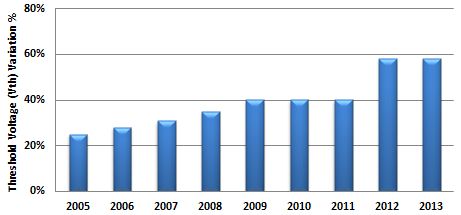 With 16 nm FinFET devices, the nature of variation changes. On planar CMOS,
random dopant fluctuations (RDFs) had the biggest influence.
With 16 nm FinFET devices, the nature of variation changes. On planar CMOS,
random dopant fluctuations (RDFs) had the biggest influence.
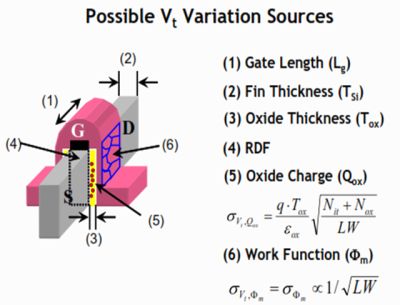 Ideal FinFETs have no doping, and therefore no RDFs. However, this only
works for low voltage operation. We also need high-speed devices, which
requires multiple threshold voltages (Vth's). For FinFETs, this requires
doping leading to RDF variation.
Furthermore, from Y. Liu at the VLSI Technology Symposium of 2010, there are
some new sources of variation such as gate lengths, fin thicknesses, oxide
thicknesses, etc. (shown in his figure above) that designers have to watch.
Because of this, TSMC, GlobalFoundries, Samsung and Intel are now providing
detailed statistical local (mismatch) and global manufacturing variation
data to 20/16/14 nm designers so they can hopefully get working silicon and
livable parametric yields -- without the designers having to over-design;
taking power, performance and area penalties.
Ideal FinFETs have no doping, and therefore no RDFs. However, this only
works for low voltage operation. We also need high-speed devices, which
requires multiple threshold voltages (Vth's). For FinFETs, this requires
doping leading to RDF variation.
Furthermore, from Y. Liu at the VLSI Technology Symposium of 2010, there are
some new sources of variation such as gate lengths, fin thicknesses, oxide
thicknesses, etc. (shown in his figure above) that designers have to watch.
Because of this, TSMC, GlobalFoundries, Samsung and Intel are now providing
detailed statistical local (mismatch) and global manufacturing variation
data to 20/16/14 nm designers so they can hopefully get working silicon and
livable parametric yields -- without the designers having to over-design;
taking power, performance and area penalties.
 Why are TSMC, GlobalFoundries, Samsung and Intel doing this? It's due to
the terrible new economic costs their customers run into when they encounter
a "Black Swan Event" like a design respin. Since sub-28 nm design and
implementation costs are more than $100 million -- a single design respin
can cost over $10 million -- PLUS the lost TTM product revenue.
(FYI -- a "Black Swan Event" is an event that is seen as highly improbable
yet causes massive consequences. It comes from the belief that all swans
are white -- until an explorer discovered black swans in Australia. The
nature of "Black Swan Events" is that people AFTER THE FACT like Monday
Morning Quarterbacks like to say it must have been obvious that black swans
would have been found because other birds have color variations, too.)
---- ---- ---- ---- ---- ---- ----
RESULT: JIM HOGAN WAS RIGHT
November 2012, Jim Hogan predicted in ESNUG 515 #7, a Custom 2.0 retooling.
As a result of the trends above, I can confirm what Jim predicted. We have
been seeing an acceleration in SPICE retooling and investment for sub-28 nm
flows. Semiconductor company goals are:
- Differentiate by creating higher performance, lower power, smaller
area products.
- Accurately predict silicon performance for sub-28 nm design without
taking overdesign and yield/failure penalties
- Reduce design, respin costs and lost revenue
Below are typical problems we've seen from traditional SPICE simulation runs
that sub-28 nm SPICE simulation flow retooling addresses:
- PVT corner variation verification of 20 nm PLL took 2 weeks
- Verify 28 nm DAC non-linearity spec at 3-sigma took 1500 hours
- Verify 16 nm std cell library to 4-sigma took weeks to simulate,
and PVT corner simulation alone led to 15-30% overdesign
- Verify 14 nm SRAM memory design at 6-sigma took an infeasible
amount of time (years) to simulate, and linearity simplification
assumptions were not silicon-accurate
The result is not just increased retooling, but also a shift in the SPICE
simulation flow criteria. At larger nodes, designers were historically
able to get away with block-level simplifications -- including linear
approximations to estimate full-circuit performance. However, now these
simplifications are no longer possible.
Additional sub-28 nm complexity has placed increased demand on tool vendors
to deliver much higher performance / much higher capacity SPICE simulators
that are silicon-accurate. For example, simulating post-layout is a must;
as layout effects such as parasitics dramatically impact the power,
performance and silicon yield.
WHAT HOGAN MISSED:
One of the things we're seeing with customer retooling is that they've added
a new requirement above the traditional "more speed, more capacity, and more
accuracy" requests -- now we see customers also asking for increased design
coverage using fewers SPICE simulations.
Why are TSMC, GlobalFoundries, Samsung and Intel doing this? It's due to
the terrible new economic costs their customers run into when they encounter
a "Black Swan Event" like a design respin. Since sub-28 nm design and
implementation costs are more than $100 million -- a single design respin
can cost over $10 million -- PLUS the lost TTM product revenue.
(FYI -- a "Black Swan Event" is an event that is seen as highly improbable
yet causes massive consequences. It comes from the belief that all swans
are white -- until an explorer discovered black swans in Australia. The
nature of "Black Swan Events" is that people AFTER THE FACT like Monday
Morning Quarterbacks like to say it must have been obvious that black swans
would have been found because other birds have color variations, too.)
---- ---- ---- ---- ---- ---- ----
RESULT: JIM HOGAN WAS RIGHT
November 2012, Jim Hogan predicted in ESNUG 515 #7, a Custom 2.0 retooling.
As a result of the trends above, I can confirm what Jim predicted. We have
been seeing an acceleration in SPICE retooling and investment for sub-28 nm
flows. Semiconductor company goals are:
- Differentiate by creating higher performance, lower power, smaller
area products.
- Accurately predict silicon performance for sub-28 nm design without
taking overdesign and yield/failure penalties
- Reduce design, respin costs and lost revenue
Below are typical problems we've seen from traditional SPICE simulation runs
that sub-28 nm SPICE simulation flow retooling addresses:
- PVT corner variation verification of 20 nm PLL took 2 weeks
- Verify 28 nm DAC non-linearity spec at 3-sigma took 1500 hours
- Verify 16 nm std cell library to 4-sigma took weeks to simulate,
and PVT corner simulation alone led to 15-30% overdesign
- Verify 14 nm SRAM memory design at 6-sigma took an infeasible
amount of time (years) to simulate, and linearity simplification
assumptions were not silicon-accurate
The result is not just increased retooling, but also a shift in the SPICE
simulation flow criteria. At larger nodes, designers were historically
able to get away with block-level simplifications -- including linear
approximations to estimate full-circuit performance. However, now these
simplifications are no longer possible.
Additional sub-28 nm complexity has placed increased demand on tool vendors
to deliver much higher performance / much higher capacity SPICE simulators
that are silicon-accurate. For example, simulating post-layout is a must;
as layout effects such as parasitics dramatically impact the power,
performance and silicon yield.
WHAT HOGAN MISSED:
One of the things we're seeing with customer retooling is that they've added
a new requirement above the traditional "more speed, more capacity, and more
accuracy" requests -- now we see customers also asking for increased design
coverage using fewers SPICE simulations.
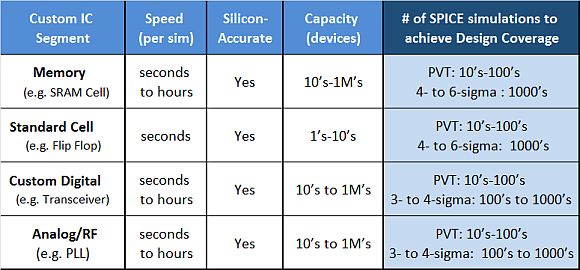 The reason why they're asking for this is because of the overall number of
SPICE simulations they have to run. For example, to characterize a 16 nm
SRAM cell can now easily take 5 billion SPICE runs.
Now the new SPICE retooling has 4 criteria instead of the usual 3 criteria
of "speed!, capacity!, accuracy!" by adding "more coverage in fewer sims!"
---- ---- ---- ---- ---- ---- ----
AMIT'S 2014 SPICE WARS UPDATE:
Let's take a look at the vendors in each of the four major SPICE segments:
The reason why they're asking for this is because of the overall number of
SPICE simulations they have to run. For example, to characterize a 16 nm
SRAM cell can now easily take 5 billion SPICE runs.
Now the new SPICE retooling has 4 criteria instead of the usual 3 criteria
of "speed!, capacity!, accuracy!" by adding "more coverage in fewer sims!"
---- ---- ---- ---- ---- ---- ----
AMIT'S 2014 SPICE WARS UPDATE:
Let's take a look at the vendors in each of the four major SPICE segments:
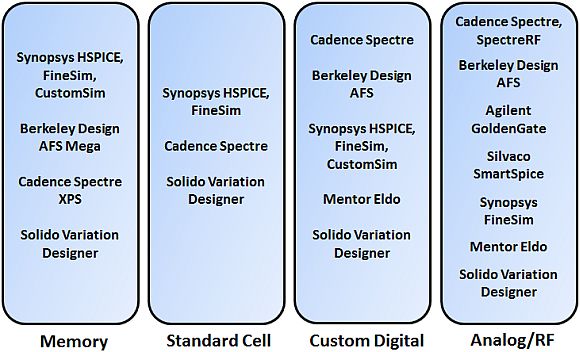 Each of these SPICE-use segments have different tool and use requirements.
Here's a breakout of each.
Memory
After Synopsys' acquisition of Magma in February 2012, Synopsys continues to
own the memory SPICE market (>80% market share) with their HSPICE, FineSim,
HSIM and CustomSim, -- from Avanti, Magma, Nassda, and their own R&D. They
have not merged any of these simulators as was originally speculated.
Some characteristics of memory designs include:
- Example designs are: bit cells, sense amps, columns, arrays
- Most design being done at leading process nodes (eg. 16/14 nm)
- Designers are running 10's-100's of SPICE simulator seats in
parallel to design, verify and characterize memory blocks
- Fabs running SPICE simulation on memory blocks to characterize
their processes and design IP for their customers
- Memory SPICE runs are done through command-line, not GUIs
- They use both true SPICE for high accuracy and Fast SPICE for
high capacity simulation
- Memory SPICE runs are often PVT and 3- to 6-sigma Monte Carlo
simulation for both design and verification
Both Cadence released their new Spectre XPS SPICE simulator and Berkeley DA
released their new AFS Mega simulator in 2013 -- in hopes to take this high
margin market niche from Synopsys. TSMC says it has adopted BDA AFS Mega.
Cadence so far has no announced major customer buy-ins of Spectre XPS.
Standard Cell
Synopsys also still dominates the standard cell SPICE simulation market with
more than 80% market share. The two major std cell SPICE simulators are
SNPS/Avanti HSPICE and SNPS/Magma FineSim. These two simulators dominate
because are tightly integrated into the Synopsys Liberty NCX and the market
dominant ex-Magma SiliconSmart standard cell characterization flows.
Some characteristics of std cell designs include:
- Example designs are: flip flops, inverters
- Most design being done at leading process nodes (eg. 16/14 nm)
- Designers are running 10's-100's of SPICE simulator seats in
parallel to design, verify and characterize std cell blocks
- Fabs running SPICE simulation on std cell blocks to design IP
libraries for their customers
- Std cell SPICE runs are done through command-line, not GUIs
- They use mosty true SPICE simulators for high accuracy, and
their runs are integrated with std cell characterization flows
- Std cell runs are often 4- to 6-sigma Monte Carlo simulation
for design and verification
Cadence bought Altos in 2011, actively hoping to capture some std cell SPICE
simulation market share for their Spectre with Virtuoso Liberate. We are
seeing CDNS/Altos Spectre getting some traction, i.e. it is being used more
by some customers for standard cell design.
Custom Digital
Cadence Spectre and Berkeley DA AFS (Analog FastSPICE) are the two major
simulators in the custom digital sub-market.
Some characteristics of custom digital designs include:
- Example designs are: SerDes, I/O's
- Design is being done at both older (eg. 45/28/22/20 nm) nodes
and leading process nodes (eg. 16/14 nm)
- Designers are running 1-10 SPICE simulator seats in parallel
to verify their custom designs
- Fabs don't usually do custom digital; their customers do it
- Custom digital SPICE runs are done through GUI's to setup and
launch simulations, and later visualize results
- They use both true SPICE simulators for high accuracy and
fast SPICE simulators for large capacity runs
- Custom digital runs are often PVT and 3- to 4-sigma Monte Carlo
Other vendors competing for this market share are Synopsys with HSPICE,
FineSim, CustomSim, and Mentor Eldo; but we mostly see Cadence Spectre
and Berkeley Design AFS simulators still dominating here.
Analog/RF
Cadence Spectre/Spectre RF and BDA Analog FastSPICE (AFS) are the two major
SPICE simulators for the analog/RF custom market. They continue to compete
aggressively.
Some characteristics of analog/RF designs include:
- Example designs are: OpAmps, PLLs, A/D or D/A converters
- Design is being done at both older (eg. 45/28/22/20 nm) nodes
and leading process nodes (eg. 16/14 nm)
- Designers are running 1-10 SPICE simulator seats in parallel
to verify their analog/RF designs
- Fabs don't usually do analog/RF; their customers do it
- Analog/RF SPICE runs are done through GUI's to setup and
launch simulations, and later visualize results
- They use both true SPICE simulators for high accuracy and
fast SPICE simulators for large capacity runs
- Analog/RF runs are often PVT and 3- to 4-sigma Monte Carlo
Other SPICE vendor simulators competing for market share in Analog/RF are
Synopsys FineSim (analog), Silvaco SmartSPICE (analog/RF), Mentor Eldo
(analog), Agilent GoldenGate (RF). We mostly see Cadence Spectre/SpectreRF
and Berkeley Design AFS used -- but with substantial Agilent GoldenGate
use for complex RF blocks.
---- ---- ---- ---- ---- ---- ----
AMIT'S SPICE PREDICTIONS FOR 2014:
Now that the CDNS/BDA lawsuit is settled and both companies' newly announced
SPICE simulators have had 6 months to harden, for 2014 I predict a shakeup in
the SPICE market:
- CDNS and BDA will chase after SNPS for the SPICE memory market
in 2014, and will announce customer wins since they have viable
product alternatives and customers want a second source supplier.
- CDNS will chase after SNPS for the SPICE std cell market in 2014,
and will announce customer wins with the Virtuoso Spectre/Altos
Liberate flow.
- CDNS and BDA will continue to battle for the SPICE custom digital
market in 2014, with BDA announcing more customer wins.
- BDA/Silvaco/Agilent/SNPS/MENT will chase after CDNS for the
SPICE analog/RF market in 2014. BDA, Silvaco and SNPS investment
will payoff in taking some market share from CDNS. Agilent and
MENT will stay status quo.
And I'm happy to say we are also seeing more SPICE variation simulation and
the need for coverage in fewer simulations, which clearly increase the need
for Solido tools -- but I might be biased on this. :)
- Amit Gupta
Solido DA Saskatoon, Canada
Each of these SPICE-use segments have different tool and use requirements.
Here's a breakout of each.
Memory
After Synopsys' acquisition of Magma in February 2012, Synopsys continues to
own the memory SPICE market (>80% market share) with their HSPICE, FineSim,
HSIM and CustomSim, -- from Avanti, Magma, Nassda, and their own R&D. They
have not merged any of these simulators as was originally speculated.
Some characteristics of memory designs include:
- Example designs are: bit cells, sense amps, columns, arrays
- Most design being done at leading process nodes (eg. 16/14 nm)
- Designers are running 10's-100's of SPICE simulator seats in
parallel to design, verify and characterize memory blocks
- Fabs running SPICE simulation on memory blocks to characterize
their processes and design IP for their customers
- Memory SPICE runs are done through command-line, not GUIs
- They use both true SPICE for high accuracy and Fast SPICE for
high capacity simulation
- Memory SPICE runs are often PVT and 3- to 6-sigma Monte Carlo
simulation for both design and verification
Both Cadence released their new Spectre XPS SPICE simulator and Berkeley DA
released their new AFS Mega simulator in 2013 -- in hopes to take this high
margin market niche from Synopsys. TSMC says it has adopted BDA AFS Mega.
Cadence so far has no announced major customer buy-ins of Spectre XPS.
Standard Cell
Synopsys also still dominates the standard cell SPICE simulation market with
more than 80% market share. The two major std cell SPICE simulators are
SNPS/Avanti HSPICE and SNPS/Magma FineSim. These two simulators dominate
because are tightly integrated into the Synopsys Liberty NCX and the market
dominant ex-Magma SiliconSmart standard cell characterization flows.
Some characteristics of std cell designs include:
- Example designs are: flip flops, inverters
- Most design being done at leading process nodes (eg. 16/14 nm)
- Designers are running 10's-100's of SPICE simulator seats in
parallel to design, verify and characterize std cell blocks
- Fabs running SPICE simulation on std cell blocks to design IP
libraries for their customers
- Std cell SPICE runs are done through command-line, not GUIs
- They use mosty true SPICE simulators for high accuracy, and
their runs are integrated with std cell characterization flows
- Std cell runs are often 4- to 6-sigma Monte Carlo simulation
for design and verification
Cadence bought Altos in 2011, actively hoping to capture some std cell SPICE
simulation market share for their Spectre with Virtuoso Liberate. We are
seeing CDNS/Altos Spectre getting some traction, i.e. it is being used more
by some customers for standard cell design.
Custom Digital
Cadence Spectre and Berkeley DA AFS (Analog FastSPICE) are the two major
simulators in the custom digital sub-market.
Some characteristics of custom digital designs include:
- Example designs are: SerDes, I/O's
- Design is being done at both older (eg. 45/28/22/20 nm) nodes
and leading process nodes (eg. 16/14 nm)
- Designers are running 1-10 SPICE simulator seats in parallel
to verify their custom designs
- Fabs don't usually do custom digital; their customers do it
- Custom digital SPICE runs are done through GUI's to setup and
launch simulations, and later visualize results
- They use both true SPICE simulators for high accuracy and
fast SPICE simulators for large capacity runs
- Custom digital runs are often PVT and 3- to 4-sigma Monte Carlo
Other vendors competing for this market share are Synopsys with HSPICE,
FineSim, CustomSim, and Mentor Eldo; but we mostly see Cadence Spectre
and Berkeley Design AFS simulators still dominating here.
Analog/RF
Cadence Spectre/Spectre RF and BDA Analog FastSPICE (AFS) are the two major
SPICE simulators for the analog/RF custom market. They continue to compete
aggressively.
Some characteristics of analog/RF designs include:
- Example designs are: OpAmps, PLLs, A/D or D/A converters
- Design is being done at both older (eg. 45/28/22/20 nm) nodes
and leading process nodes (eg. 16/14 nm)
- Designers are running 1-10 SPICE simulator seats in parallel
to verify their analog/RF designs
- Fabs don't usually do analog/RF; their customers do it
- Analog/RF SPICE runs are done through GUI's to setup and
launch simulations, and later visualize results
- They use both true SPICE simulators for high accuracy and
fast SPICE simulators for large capacity runs
- Analog/RF runs are often PVT and 3- to 4-sigma Monte Carlo
Other SPICE vendor simulators competing for market share in Analog/RF are
Synopsys FineSim (analog), Silvaco SmartSPICE (analog/RF), Mentor Eldo
(analog), Agilent GoldenGate (RF). We mostly see Cadence Spectre/SpectreRF
and Berkeley Design AFS used -- but with substantial Agilent GoldenGate
use for complex RF blocks.
---- ---- ---- ---- ---- ---- ----
AMIT'S SPICE PREDICTIONS FOR 2014:
Now that the CDNS/BDA lawsuit is settled and both companies' newly announced
SPICE simulators have had 6 months to harden, for 2014 I predict a shakeup in
the SPICE market:
- CDNS and BDA will chase after SNPS for the SPICE memory market
in 2014, and will announce customer wins since they have viable
product alternatives and customers want a second source supplier.
- CDNS will chase after SNPS for the SPICE std cell market in 2014,
and will announce customer wins with the Virtuoso Spectre/Altos
Liberate flow.
- CDNS and BDA will continue to battle for the SPICE custom digital
market in 2014, with BDA announcing more customer wins.
- BDA/Silvaco/Agilent/SNPS/MENT will chase after CDNS for the
SPICE analog/RF market in 2014. BDA, Silvaco and SNPS investment
will payoff in taking some market share from CDNS. Agilent and
MENT will stay status quo.
And I'm happy to say we are also seeing more SPICE variation simulation and
the need for coverage in fewer simulations, which clearly increase the need
for Solido tools -- but I might be biased on this. :)
- Amit Gupta
Solido DA Saskatoon, Canada
Join
Index
Next->Item
|
|



